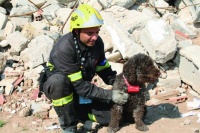
The number of victims in these situations is often unknown and the responsibility of calling off the search-and-rescue operation lies with the emergency co-ordinator. His or her decision is based on a judgement call that relies heavily on memory to assess how extensively an area has been covered.
’This is a very difficult decision that requires experience and instinct,’ said Dr José Caro Ramón, from Spanish technology firm GMV. ’Our system is an attempt to provide more certainty to rescue co-ordinators by using solid data.’
The technology, known as Osmografo, combines information on the scenting abilities of the dog with data on its location. This information is transmitted from a receiver on the dog’s collar to a central monitoring unit that contains sensors to measure wind speed and direction.
Once all the data has been gathered, a software package is used to produce a real-time map of the area covered by the canine rescue teams. Other details, such as danger zones and locations of known victims, are automatically included to help rescuers make rapid decisions on the best course of action.
’Combining all of this information is crucial in getting a better idea of how thoroughly an area has been searched,’ said Ramón. ’Wind is a major factor that can help the dog cover a much larger area. A moderate wind can allow a dog’s sense of smell to increase by a more than a few dozen metres.’
The system can work in the absence of a telecommunication infrastructure by using industrial scientific and medical (ISM) radio bands. Ramón added: ’The one difficultly we’ve had so far in testing is instability in the communication module so, while it is ready for training purposes, in an operational situation the signal could be blocked by other buildings.’
Engineers from GMV are now working alongside volunteers from the K9 non-governmental organisation to solve the communications problem for operational requirements.
In the meantime, Ramón believes that the system could provide a valuable tool in training scenarios where an absence of buildings means that a stronger signal can be obtained.








Water Sector Talent Exodus Could Cripple The Sector
'Capricious changes of priority by the general public'?!? Surely the public would demand both sufficient water supply and sufficient waste...